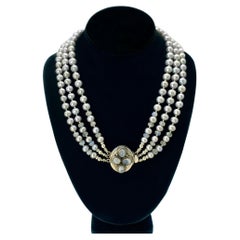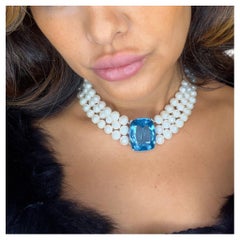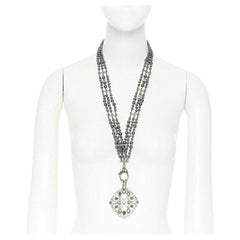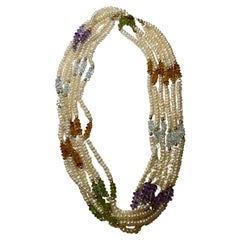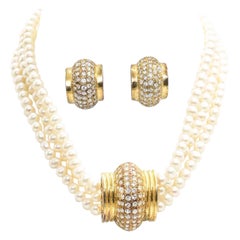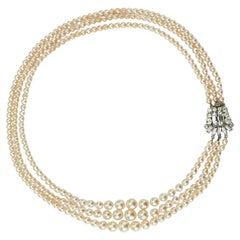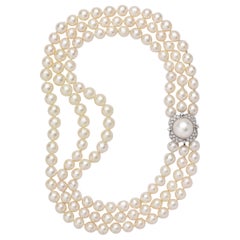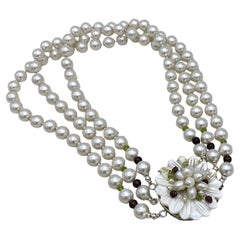Triple Strand Pearls
2010s American Artisan Multi-Strand Necklaces
Moonstone, Pearl, Sterling Silver
2010s North American Choker Necklaces
Pearl, Topaz, Blue Topaz, Rhodium, Sterling Silver
2010s French Pendant Necklaces
Antique Early 19th Century Multi-Strand Necklaces
Diamond, Natural Pearl, Gold, Platinum
Vintage 1970s American Baroque Multi-Strand Necklaces
Late 20th Century Multi-Strand Necklaces
Gilt Metal
Vintage 1950s American Multi-Strand Necklaces
Mid-20th Century German Retro Multi-Strand Necklaces
Diamond, Pearl, Gold, 14k Gold, White Gold
2010s American Artisan Multi-Strand Necklaces
Garnet, Pearl, Peridot, Sterling Silver, Stainless Steel
Early 20th Century English Victorian Beaded Bracelets
Diamond, Turquoise, Cultured Pearl, Yellow Gold
2010s American Multi-Strand Necklaces
Diamond, Pearl, Sterling Silver
21st Century and Contemporary Japanese Multi-Strand Necklaces
Diamond, Pearl, White Gold
21st Century and Contemporary Japanese Multi-Strand Necklaces
Diamond, Pearl, White Gold
21st Century and Contemporary Japanese Multi-Strand Necklaces
Diamond, Pearl, 18k Gold
21st Century and Contemporary Japanese Multi-Strand Necklaces
Diamond, Pearl, White Gold
21st Century and Contemporary Multi-Strand Necklaces
Labradorite, Pearl, Quartz, 14k Gold, Yellow Gold
21st Century and Contemporary Japanese Multi-Strand Necklaces
Pearl, Diamond, South Sea Pearl, White Gold
2010s Multi-Strand Necklaces
Cultured Pearl
Mid-20th Century American Modern Multi-Strand Necklaces
Onyx, Pearl, Cultured Pearl, Gold, 18k Gold, Yellow Gold
21st Century and Contemporary Japanese Beaded Bracelets
Diamond, Pearl, White Gold
2010s American Regency Multi-Strand Necklaces
Amethyst, Natural Pearl, Gold-filled
21st Century and Contemporary Italian Artist Multi-Strand Necklaces
Diamond, Pearl, 18k Gold, White Gold
21st Century and Contemporary Unknown Modern Multi-Strand Necklaces
Diamond, Pearl, 14k Gold, Yellow Gold
2010s American Artisan Multi-Strand Necklaces
Pearl, Zircon, Blue Zircon, Silver Plate
21st Century and Contemporary American Multi-Strand Necklaces
Coral, Pearl, Mixed Metal
21st Century and Contemporary Italian Artist Multi-Strand Necklaces
Pearl, Diamond, 18k Gold, White Gold
2010s Turkish Artist Beaded Necklaces
Pearl, Gold-filled, Sterling Silver, 24k Gold
21st Century and Contemporary Japanese Multi-Strand Necklaces
Diamond, Pearl, Turquoise, White Gold
Vintage 1970s Multi-Strand Necklaces
Vintage 1980s Multi-Strand Necklaces
Diamond, Pearl, Tourmaline, 14k Gold
Vintage 1980s French Multi-Strand Necklaces
Gilt Metal
2010s Multi-Strand Necklaces
2010s Multi-Strand Necklaces
Cultured Pearl, Natural Pearl
21st Century and Contemporary American Modern Multi-Strand Necklaces
Coral, Onyx, Pearl, Sterling Silver
Late 20th Century Modern Multi-Strand Necklaces
Vintage 1950s American Beaded Necklaces
Cultured Pearl
2010s American Art Deco Beaded Bracelets
Pearl, Yellow Gold
Antique 16th Century European Art Deco Beaded Bracelets
Diamond, Pearl, Platinum
21st Century and Contemporary Japanese Beaded Bracelets
Diamond, Pearl, Aquamarine, White Gold
2010s Beaded Bracelets
Pearl, 14k Gold, Yellow Gold
2010s Beaded Necklaces
Pearl
Vintage 1950s European Artisan Beaded Necklaces
Pearl, Mixed Metal
Vintage 1960s Beaded Necklaces
Pearl, 14k Gold
21st Century and Contemporary Japanese Beaded Bracelets
Diamond, Pearl, White Gold
21st Century and Contemporary Japanese Beaded Bracelets
Diamond, Pearl, 18k Gold
21st Century and Contemporary Japanese Beaded Bracelets
Diamond, Pearl, 18k Gold
21st Century and Contemporary Italian Artist Drop Necklaces
Pearl, Black Pearl, Ruby, Diamond, 18k Gold
21st Century and Contemporary Drop Necklaces
Diamond, Pearl, South Sea Pearl, Gold, 18k Gold
2010s Beaded Necklaces
Pearl, Sterling Silver
Vintage 1950s Choker Necklaces
Gilt Metal
Mid-20th Century Unknown Beaded Bracelets
Diamond, Cultured Pearl, 14k Gold, White Gold
Late 20th Century Drop Necklaces
1990s Modern Pendant Necklaces
Pearl, 18k Gold, White Gold
20th Century French Beaded Necklaces
Gilt Metal
21st Century and Contemporary Beaded Necklaces
Pearl, 18k Gold
Late 20th Century French Artist Link Necklaces
Diamond, Pearl
21st Century and Contemporary Japanese Dangle Earrings
Diamond, Pearl, White Gold
Vintage 1920s Art Deco Drop Necklaces
Natural Pearl, Onyx, Tourmaline, White Diamond, Platinum
- 1
Triple Strand Pearls For Sale on 1stDibs
How Much are Triple Strand Pearls?
- 1stDibs ExpertNovember 8, 2023You can wear many kinds of earrings with a strand of pearls. Create a unified look by opting for pearl earrings like studs, clusters and drops. A pair of hoop earrings can also complement pearls, as can more dramatic dangle earrings set with gemstones. When choosing earrings, consider the occasion. Bolder, larger earrings tend to be more appropriate for night and special events. Explore a wide variety of earrings on 1stDibs.
- 1stDibs ExpertNovember 27, 2023The tradition of the royals wearing three strands of pearls comes from Queen Elizabeth II. Her father, King George VI, presented her with a three-strand pearl necklace on her wedding day, and she wore the necklace many times in the years that followed. To honor the late queen, Kate Middleton, the Duchess of York, wore the queen's three-strand pearl necklace to Elizabeth II's funeral. The royal tradition of wearing pearls as mourning jewelry traces back to Queen Victoria. On 1stDibs, find a large selection of pearl necklaces.
Read More
This Victorian Necklace Features a Rainbow of Gems
If jewelry could talk, we know this piece would have good stories.
A Centuries-Old Style, Lockets Have Never Lost Their Romantic Appeal
Emblems of heartfelt emotion, elegant vessels for photos and keepsakes and perfect for layering, these special ornaments are an essential component of any thoughtfully curated jewelry collection.
This Van Cleef & Arpels Necklace Is an Heirloom in the Making
With more than 100 carats of diamonds, this vintage stunner converts into different styles, making it as versatile as it is breathtaking.
[Survey] Two-Thirds of Jewelry Gift Recipients Don’t Want to Be Surprised
Givers of fine gems enjoy surprise more than receivers, and women more than men. Find out what else our survey of 3,000 Americans revealed.
Next-Level Pearls That Go Well Beyond the Expected
Organic shapes, surprising textures, shimmering colors and inventive embellishments take the new generation of pearl jewelry from classic to cutting-edge.
7 Vibrant Jewels for a Breezy Late-Summer Wardrobe
Soak up the pleasures of the season with a these bold gems.
Whether Worn Alone or Layered, These Chain Link Necklaces Are Trending
Learn more about the stylish links that have passed the test of time.
Meet the Dapper, Mustachioed Parisian Who’s Tops in Crafting Enticing Jewels
After more than a decade creating the iconic Lanvin gems of the Alber Elbaz years, designer Elie Top dove into the world of fine jewelry, mixing silver and gold to create his own striking, timeless look.
